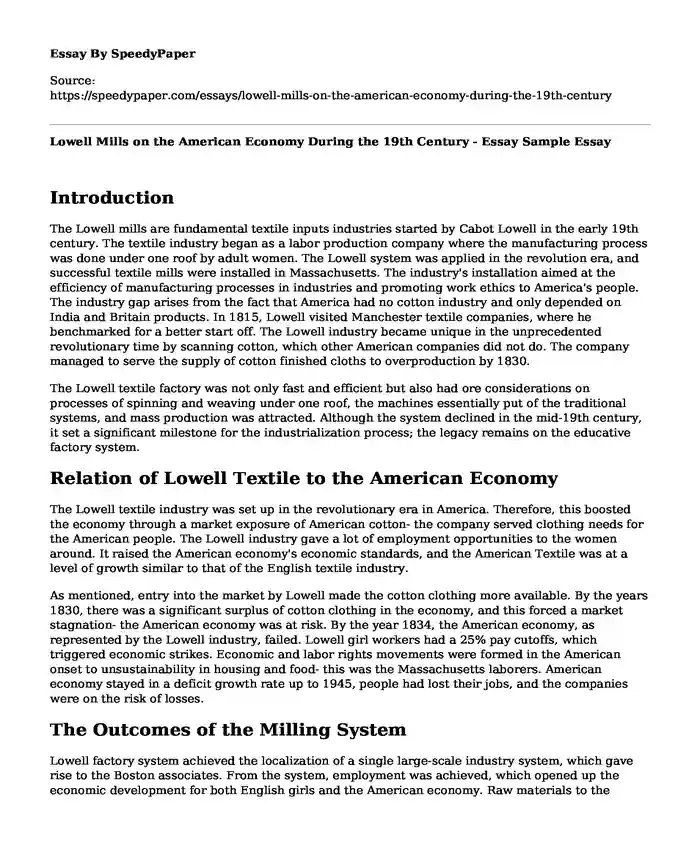
| Type of paper: | Essay |
| Categories: | United States Economics |
| Pages: | 3 |
| Wordcount: | 620 words |
Introduction
The Lowell mills are fundamental textile inputs industries started by Cabot Lowell in the early 19th century. The textile industry began as a labor production company where the manufacturing process was done under one roof by adult women. The Lowell system was applied in the revolution era, and successful textile mills were installed in Massachusetts. The industry's installation aimed at the efficiency of manufacturing processes in industries and promoting work ethics to America's people. The industry gap arises from the fact that America had no cotton industry and only depended on India and Britain products. In 1815, Lowell visited Manchester textile companies, where he benchmarked for a better start off. The Lowell industry became unique in the unprecedented revolutionary time by scanning cotton, which other American companies did not do. The company managed to serve the supply of cotton finished cloths to overproduction by 1830.
The Lowell textile factory was not only fast and efficient but also had ore considerations on processes of spinning and weaving under one roof, the machines essentially put of the traditional systems, and mass production was attracted. Although the system declined in the mid-19th century, it set a significant milestone for the industrialization process; the legacy remains on the educative factory system.
Relation of Lowell Textile to the American Economy
The Lowell textile industry was set up in the revolutionary era in America. Therefore, this boosted the economy through a market exposure of American cotton- the company served clothing needs for the American people. The Lowell industry gave a lot of employment opportunities to the women around. It raised the American economy's economic standards, and the American Textile was at a level of growth similar to that of the English textile industry.
As mentioned, entry into the market by Lowell made the cotton clothing more available. By the years 1830, there was a significant surplus of cotton clothing in the economy, and this forced a market stagnation- the American economy was at risk. By the year 1834, the American economy, as represented by the Lowell industry, failed. Lowell girl workers had a 25% pay cutoffs, which triggered economic strikes. Economic and labor rights movements were formed in the American onset to unsustainability in housing and food- this was the Massachusetts laborers. American economy stayed in a deficit growth rate up to 1945, people had lost their jobs, and the companies were on the risk of losses.
The Outcomes of the Milling System
Lowell factory system achieved the localization of a single large-scale industry system, which gave rise to the Boston associates. From the system, employment was achieved, which opened up the economic development for both English girls and the American economy. Raw materials to the cotton industry supported the betterment of transport systems. The government played a transformation role in the networking of the transport sector. Transport was transited from simple water and horse movements into better roads, canal, and railways. Industrialization is the most remarkable achievement that the Lowell factory system achieved in the northern hemisphere; America had no better industry operations, but the machinery introduced by Lowell was the best. Market revolution is an achievement of the factory system; the entrepreneurs had a secure way of initiating investments. A new system of factories, working women, and the wage-labor movement was enacted. The labor reform movements achieved a strict discipline and rights for employees applicable even in the current era.
Bibliography
Brooks, Rebecca. 2017. "What Was The Lowell System?". Historyofmassachusetts.Org. https://historyofmassachusetts.org/lowell-mills-factory-system/.
Pioneers. 2020. "Who Made America? | Innovators | Francis Cabot Lowell". Pbs.Org. https://www.pbs.org/wgbh/theymadeamerica/whomade/lowell_hi.html.
US History Organization. 2020. "Economic Growth And The Early Industrial Revolution [Ushistory.Org]". Ushistory.Org. https://www.ushistory.org/us/22a.asp.
Cite this page
Lowell Mills on the American Economy During the 19th Century - Essay Sample. (2023, Dec 13). Retrieved from https://speedypaper.net/essays/lowell-mills-on-the-american-economy-during-the-19th-century
Request Removal
If you are the original author of this essay and no longer wish to have it published on the SpeedyPaper website, please click below to request its removal:
- Free Essay Describing Social Cohesion Example
- Healthy Ageing
- Free Essay with an Economic Analysis of Inflation and Unemployment
- Free Essay on Energy Crisis
- Michigan's Relationship Between Climate, Soils, and Forestry. Paper Example
- Market Structure - Free Paper Example
- From Struggles to Triumphs: The Evolution of the Civil Rights Movement (1950s-2010s) - Paper Sample
Popular categories




